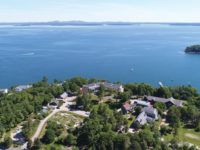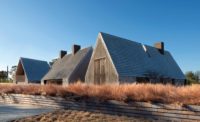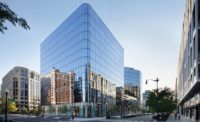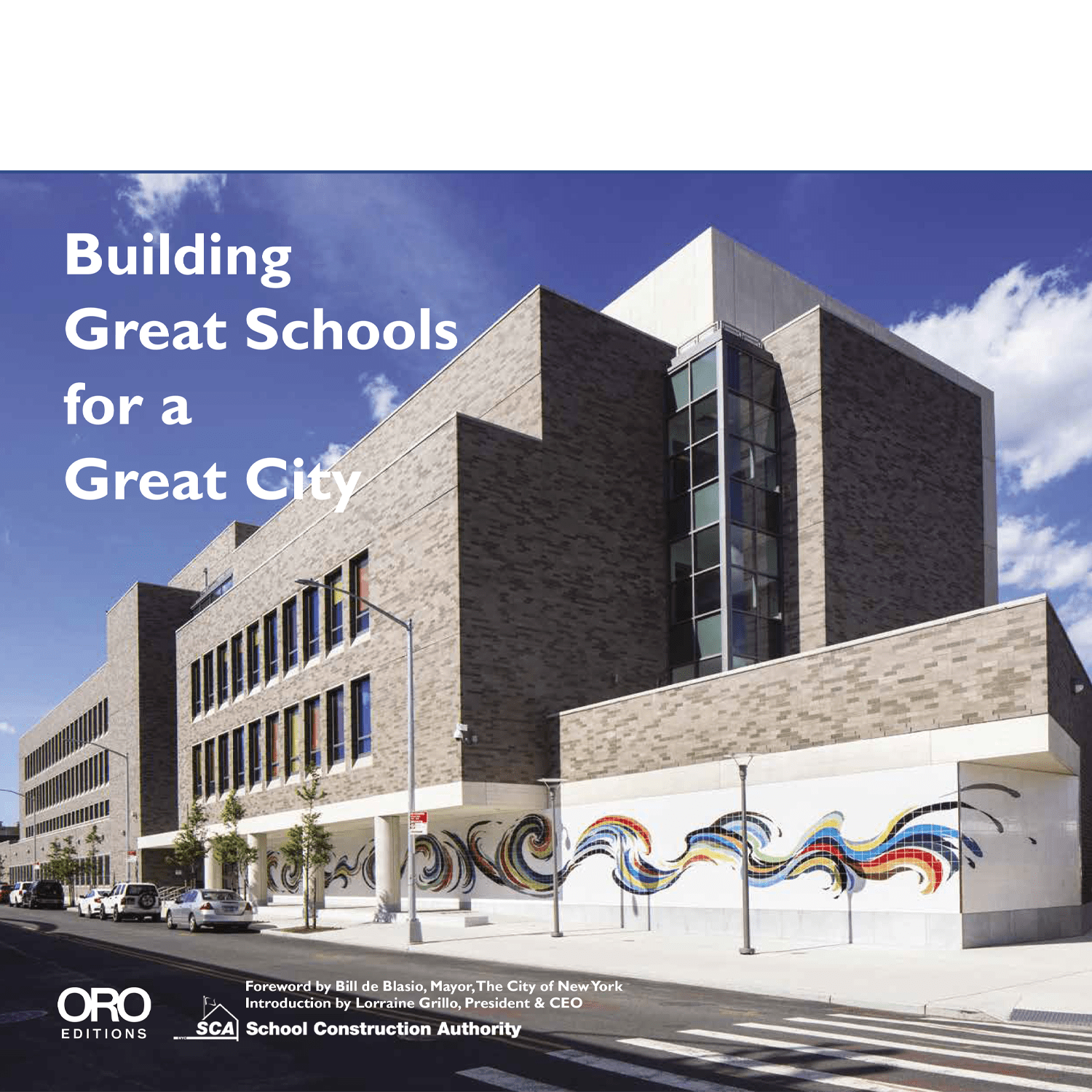A challenge architects constantly face in designing contemporary additions to historic buildings is how to meld old and new vocabularies so each has its own integrity. The Boston firm NADAAA confronted this dilemma in renovating and enlarging Knox College, a Presbyterian seminary built in 1875, for the John H. Daniels Faculty of Architecture, Landscape, and Design at the University of Toronto, an expansion of the graduate school, previously located in an existing building nearby.
Additional Content:
Jump to credits & specifications
NADAAA’s solution is both ingenious and off-putting. To create a dialogue between the historic and the contemporary, NADAAA principals Nader Tehrani and Katherine Faulkner veered toward dissonance—particularly on the elevations where the two architectural expressions come together. While inventive architects often consider discordant motifs to be integral to modernity’s aesthetic ethos, these can be discombobulating. Nevertheless, NADAAA’s reputation is based on its exploration of that often uncomfortable dynamic, which explains a lot about the firm’s approach here.
The design concept owes much to the prominent, unusual site, One Spadina Crescent, a circle in the middle of north–south Spadina Avenue, near downtown, where the smaller Russell Street forms a cross axis. There, in the middle of a traffic roundabout, sits Knox, the monumental neo-Gothic pile, designed by Toronto architects Smith & Gemmell and acquired by the university in 1972; most recently, it had been a laboratory. The building majestically faces south—the avenue splits and flows entirely around it. In expanding the U-shaped landmark, the architects wanted to complete the circle with a strong north-facing identity.
Here the architects placed a Miesian curtain wall, with fritted glass, to present a calm, elegant demeanor unlike the busier 19th-century brick facade facing south. A sloped walk, excavated from the ground plane and edged by earth berms, takes students and faculty down to a lower level, where folding glass doors open up to bright yellow–painted workshops and fabrication labs—energetically announcing the architecture school’s 21st-century program. Overall, the expansion, a bold steel, concrete, and glass structure with open and flexible spaces for studios, discussion areas, lounges, and labs, now totals 155,000 square feet, including the Knox. Working with preservation architects ERA, NADAAA sensitively renovated the old building for a library, classrooms, and offices.
On the east and west sides of the building are the junctures where the golden-ish brick of the original building ends, and the gray high-performance concrete panels cladding the new wing begin. The encounter is fractious. While Tehrani and Faulkner have abstractly echoed the vertical lines and scale of the neo-Gothic Knox building in their expansion, the discordant schism is primarily due to the drab color and flatness of the concrete panels. The architects regard the skin’s texture as akin to gray flannel: this observer sees it looking more like a thick gray cardboard.
Since there are now four facades with entrances—the former main one on the south will soon have a generous terrace, a “belvedere,” to welcome visitors to the administrative portion of the school—the first-time visitor might be confused about where to enter. The landscaping, by the Toronto firm Public Work, is meant to give a subtle clue (maybe too subtle) by the way it changes from native grasses on the south to more formal yew, white birch, and oak, among other trees, near the new main entrance on the east facade. Public Work’s principals, Adam Nicklin and Marc Ryan, sought a range of local plants to provide a laboratory for the landscape students at the school.
As you enter on the east of this three-story complex, you find that, inside, a corridor or “street” extends through the new addition to the door on the west side. The street widens on the north for a café and lounge, while the south is walled off where the architects filled in the existing Knox College courtyard with a two-story-high multipurpose hall.
This double-height central hall, seating over 400 with the help of bleachers, is sparked up by colorfully painted plywood strips on the walls. A triangular section of stepped seating, like an open stair outside the volume, between the second and third floors, overlooks the hall and simultaneously connects to the design studio for graduate students at the top. This idiosyncratic gesture raises a question about the triangular seating area’s function. Seeing and hearing anything in the central hall below from these bleachers/stairs may not be easy. (This visitor saw it when the hall wasn’t in use.) But it does provide an informal meeting space—and it makes a great Instagram shot.
The architectural coup de théatre is, without a doubt, the third-level design studio. The large, open space, extending across the entire north face, is column-free and suspended from four scissor trusses. (Tehrani cites the Firth of Forth Bridge in Scotland as an engineering inspiration.) The sculptural ceiling’s warped gypsum board folds admit daylight from cats-eye-shaped clerestories in the serrated roof.
Throughout the interior, cutout ceilings with glimpses of other floors create an architecturally dramatic spatial experience that heightens the sense of interconnectivity between the levels. As Tehrani says, “The section is where it is happening. The plan is dumb.” And the section delivers in spades. For example, if you are standing in the old renovated library on the main level, you can peer down into the book stacks on the floor below, where V-shaped braces support the load of the bleachers in the central hall.
Aside from the trusses, the structure is conventional—steel columns and concrete deck—except that the concrete floors make use of a voided-slab system that incorporates hollow plastic spheres, reducing the weight of these elements and providing long spans with less of a carbon footprint. These decks are also fitted with hydronic tubing for radiant heating and cooling. Such energy-efficient and sustainable characteristics apply to the roof as well, which serves as a laboratory for testing green roof planting and irrigation systems. Next the school hopes to integrate photovoltaic panels into this lab.
NADAAA, which grew out of Office dA (with partner Mónica Ponce de León) was selected in 2009 to renovate the original architecture school from a short list that included Steven Holl Architects in New York and Sauerbruch Hutton in Berlin. But a new dean, Richard Sommer, convinced the university school to bring together all 375 graduate students in architecture, landscape, and urban design with 1,000 undergraduate architecture and art/visual-studies majors into one school, or “faculty,” and move to another site: Knox College.
Office dA’s imaginative renovation of the Fleet Library at Rhode Island School of Design in 2006 (where Tehrani studied architecture before going off to Harvard Graduate School of Design, as did Sommer) no doubt helped win the commission. Now Tehrani has the distinction of working on three architecture schools recently, all with the similar focus of dynamism born of structure. The first completed was the renovation (replete with suspended mezzanine) of the 1930s modernist Hinman Research Building for the architecture school at Georgia Institute of Technology in Atlanta in 2011, the year Tehrani and Ponce de León dissolved their partnership and Tehrani formed NADAAA. Then his office collaborated with the Australian firm of John Wardle Architects on the School of Design at the University of Melbourne (2014), where studios are suspended within an interior tower.
The third architecture school—Toronto’s—completed in the fall of 2017, is considered a success. According to Sommer, increasing the scale and budget of the project—the construction cost was almost $52 million—was worth it: graduate school applications, he says, have doubled since Daniels opened. The new building, despite some details that are rough around the edges, shows NADAAA’s ability to think big—in terms of technology, sustainability, and deployment of space. All the firm’s buildings, particularly its architecture schools, exemplify its adventurous and unabashed approach. Although the results may be jarring in places, they are hardly timid or boring.
CreditsArchitect: NADAAA
Personnel in architect's firm who should receive special credit: Principals: Katherine Faulkner, AIA, OAA; Nader Tehrani
Architect of record: Adamson Associates Architects
Engineers: Structural: Entuitive Corporation Consultants: Heritage Consultant: ERA Architects General contractor: Eastern Construction Company Ltd.
Photographer: Nic Lehoux T. +1. 646.808.7535. USA. | +1. 604.805.1811 international www.niclehoux.com |
SpecificationsStructural System Addition: Manufacturer of any structural components unique to this project: W.R.Meadows (concrete finishing) Exterior Cladding Masonry: Masonry: Limen Group Constr. Ltd (subcontractor) Metal/glass curtain wall: Alumicor (curtainwall) Precast concrete: Exterior Wall Systems TAKTL (ultra high performance concrete)
Roofing Other: Sarnafil, Fibergrate, Vegetal I.D (green roof)
Windows Metal frame: Daybar (hollow metal)
Glazing Glass: Glass: Oldcastle Skylights: IBG Canada Ltd (skylight)
Doors Entrances: Acudor (access doors) Upswinging doors, other: Corflex (bi-fold lifting door)
Hardware Security devices: Honeywell Other special hardware: K.N Crowder, Sargent, McKinney, Gallery Specialty Hardware, Trimco, Ives, Glynn-Johnson, Horton Interior Finishes Acoustical ceilings: Lindner Group (acoustical ceiling baffles) Cabinetwork and custom woodwork: LG Hi-Macs (solid surface) Paints and stains: Sika, Dulux, Glidden, PPG Wall coverings: Ezobord (tackable, acoustic board) Solid surfacing: Armstrong (acoustic drywall framing system) Floor and wall tile: Concrete in most spaces: W.R.Meadows (concrete finishing) Resilient flooring: McGill Architectural Products (floor mat grille)
Furnishings Office furniture: Most of the millwork and furnishings were created in-house by the Faculty's workshop Chairs: The stools near the cafe area are Miura by Plank Tables: The tables near the cafe area are Miura by Plank
Lighting Interior ambient lighting: Metalumen, Lumium Lighting, Linear Lighting Corp, Senso Lighting, Paco Lighting, Birchwood Lighting, Lumax Lighting, Kenall Lighting, GE, Sistemalux, Custom Metalcraft, Bartco Lighting, Lucifer Lighting Co., Litelab Corp Exterior: TMS Lighting, Lumenton Lighting, GVA Lighting, Evolve, Rab Design Lighting, Iguzzini, Solera Corp Dimming system or other lighting controls: Lutron
Conveyance Elevators/escalators: Kone
Plumbing American Standard, Delta, Centoco, Chicago Faucets, Acorn Engineering , Stern-Williams, Bobrick
Energy Add any additional building components or special equipment that made a significant contribution to this project: Fire Services |
























